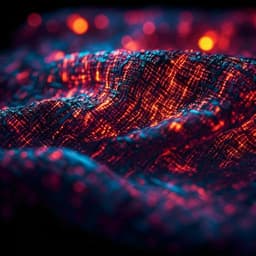
Engineering and Technology
Intrinsically stretchable OLEDs with a designed morphology-sustainable layer and stretchable metal cathode
J. Oh, K. Jeon, et al.
Discover how innovative researchers Je-Heon Oh, Kun-Hoo Jeon, and Jin-Woo Park have developed intrinsically stretchable organic light-emitting diodes (is-OLEDs) that defy traditional performance limitations, achieving remarkable luminance and durability through advanced materials and fabrication techniques.
~3 min • Beginner • English
Introduction
This study addresses the challenge of fabricating intrinsically stretchable OLEDs (is-OLEDs) with high efficiency and durability without relying on lamination, which often causes misalignment, voids, delamination, and degraded performance. Conventional solution processing suffers from non-orthogonal solvents that disrupt the designed microstructure of underlying layers, reducing stretchability. Prior work largely focused on making emissive layers stretchable via blending or molecular design, but less attention was paid to electron-transport layers (ETLs), electrodes, and process integration. The authors propose a sequentially coated is-OLED using a morphology-sustainable ETL that preserves the extended morphology of the stretchable emissive layer and an intrinsically stretchable metallic Ag cathode formed by tuning deposition conditions, aiming to achieve high luminance, efficiency, and cyclic stretchability.
Literature Review
Stretchable OLED strategies include embedding rigid nanostructures in elastomers, strain engineering, and intrinsically stretchable polymers, each with trade-offs in performance, stretchability, or resolution. Prior is-OLED efforts improved EML stretchability using additives (e.g., Triton X-100, PEO-PPG-PEO, PU, SBS) and soft segments (alkyl chains, butadiene, polyisoprene) or TADF emitters. However, solution processing frequently damaged underlayers due to solvent non-orthogonality, prompting widespread use of lamination between EML/ETL/cathode interfaces, which introduces alignment and pressure-induced defects and dark spots, especially under repeated strain. Stretchable electrodes such as AgNWs, graphene, and PEDOT:PSS require transfers/laminations or risk underlayer damage from polar solvents and have inferior conductivity relative to metals. There remains a need for intrinsically stretchable ETLs and metal cathodes compatible with sequential coating to simplify fabrication and enhance reliability.
Methodology
Materials and layer design: The intrinsically stretchable hole transport layer (is-HTL) used PEDOT:PSS blended with Triton X-100 (TX). The intrinsically stretchable emissive layer (is-EML) used Super Yellow (SY, PDY-132) blended with TX to induce an extended-chain morphology and enhance stretchability. A morphology-sustainable intrinsically stretchable ETL (is-ETL) was formulated from PFN-Br and PEIE with TX (ternary blends with ratios 2:2:0, 2:2:1, 2:2:2) to both provide mechanical compliance and preserve the extended morphology of the underlying SY:TX during sequential coating. An upper ETL of Cs2CO3-doped PEIE (d-PEIE) was prepared by codissolving PEIE and Cs2CO3 in 2-methoxyethanol and thermally treating to form a dipole-rich electron injection layer. The cathode was Ag deposited by thermal evaporation with controlled rate and nominal thickness to yield a partially connected, stretchable morphology.
Solutions and processing: is-EML solution: TX dissolved in toluene (2.5 mg mL^-1) followed by SY (5 mg mL^-1) and stirred at 60 °C for 12 h; spin-coated onto is-HTL and annealed. is-HTL: PEDOT:PSS (AI 4083) diluted 1:1 with IPA plus 5 wt% TX; spin-coated and annealed. is-ETL: PEIE and TX dissolved in methanol (4 mg mL^-1); PFN-Br added and blended to specified ratios; spin-coated and annealed. Upper ETL (d-PEIE): PEIE:Cs2CO3 = 10:1 (w/w) in 2-methoxyethanol at 4 wt%, sonicated and stirred at 80 °C for 12 h; spin-coated on Ag and annealed.
Stretchable substrate and anode: Ag nanowires (AgNWs, 30 nm dia., 30 µm length) were spray-coated through a mask onto FOTS-treated glass, embedded with an aerogel interlayer and PDMS (Sylgard 184) layers, then cured and released to form an AgNW-embedded PDMS stretchable anode.
Device fabrication: is-OLEDs were sequentially fabricated on the AgNW-PDMS anode: oxygen plasma treatment; spin-coat is-HTL; spin-coat is-EML; spin-coat is-ETL (PFN-Br:PEIE:TX, 5000 rpm, 30 s); thermally evaporate Ag cathode at controlled rate to ~60 nm (Ag60); spin-coat upper ETL (4 wt% d-PEIE) on Ag; release device from glass. A 3×2 array was fabricated with patterned electrodes similarly.
Optimization of Ag cathode: Ag films were deposited at varying thicknesses (Ag20–Ag100) and rates (≤1 Å s^-1 to >1 Å s^-1) to map Volmer–Weber growth regimes: Stage I (discrete islands), Stage II (partially connected films), Stage III (continuous films). Ag60 at 1 Å s^-1 produced a partially connected morphology with low sheet resistance and high stretchability.
Reference devices: Rigid ITO-based OLEDs were fabricated (ITO/HTL/EML/is-ETL/Al) to assess ETL electrical performance. Electron-only devices (Ag/d-PEIE/EML/is-ETL/Al) evaluated ETL injection/transport.
Characterization: Morphology via AFM, FE-SEM, TEM, TOF-SIMS; optical properties by UV–Vis and PL; work function by UPS; electrical/EL via J–V–L using a Keithley 2400 and Konica-Minolta CS-200/2000; optical transmittance by UV–Vis. Mechanical testing used static and cyclic stretching on PDMS-mounted films; crack onset strain (COS) measured under solvent treatments. Device performance under strain measured as relative luminance at 8 V; cyclic tests up to 300 cycles at 40% strain.
Key Findings
- Morphology-sustainable ETL: Adding TX to the PFN-Br:PEIE ETL solvent preserves the extended-chain morphology of SY:TX during sequential coating, as evidenced by redshifted absorbance, blueshifted PL, and increased crack onset strain (COS). Solvent-only overcoats reverted SY toward pristine morphology, while TX-containing solvents restored/maintained extended morphology.
- Mechanical properties: SY:TX EMLs showed increased COS; is-ETLs with PFN-Br:PEIE:TX (2:2:2) exhibited uniform morphology and COS up to 100% when coated on PDMS and matched the EML’s COS when coated atop the is-EML.
- Electrical properties of ETL: UPS showed Ag work function reduced from 4.8 eV to ~3.25–3.35 eV with PFN-Br:PEIE:(TX), enabling favorable electron injection. Electron-only devices showed higher current density with PFN-Br:PEIE than PFN-Br, further increased with TX addition.
- Stretchable Ag cathode optimization: Partially connected Ag films (Stage II) optimized at Ag60 and 1 Å s^-1 achieved a balance of conductivity and stretchability: sheet resistance ~6 Ω sq^-1; maintained Rs/Rs0 < 10 up to 70% strain; sustained conductivity over 200 cycles at 40% strain. Higher thickness (≥Ag60–Ag100) improved luminance but reduced stretchability; faster deposition (>1 Å s^-1) degraded performance under strain.
- Conduction mechanism under strain: Microcrack widening under strain with preserved percolation via connected Ag grains; cracks closed upon release, maintaining stability. Intermixing at the Ag/ETL interface (TEM/TOF-SIMS) enhanced adhesion. Overcoated d-PEIE increased contact area and electron injection without hindering Ag growth when placed above the cathode.
- Device metrics: is-OLEDs showed turn-on ~6 V. From the AgNW anode side: luminance ≈2340 cd m^-2 at 9 V, current efficiency ≈4.2 cd A^-1. From the semitransparent Ag cathode side: luminance ≈811 cd m^-2, current efficiency ≈1.2 cd A^-1. Total (both sides combined): maximum luminance 3151 cd m^-2, current efficiency 5.4 cd A^-1.
- Stretchability: At 8 V, relative luminance retained ≈75% at 40% strain, ≈55% at 60%, ≈45% at 70%. Under 40% cyclic strain, devices maintained ≈80% luminance after 300 cycles (initial drop to ~85% by 50 cycles then stabilized).
- Fabrication/process: Sequential coating avoided lamination, reduced fabrication complexity, and delivered higher cyclic stretchability compared to lamination-based is-OLEDs while achieving comparable luminance/efficiency.
Discussion
The work demonstrates that a morphology-sustainable ETL (PFN-Br:PEIE:TX) can preserve the extended-chain morphology of the SY:TX EML during sequential solution processing, overcoming solvent orthogonality issues that typically compromise stretchability. By aligning the mechanical compliance of ETL and EML and maintaining favorable energy levels for electron injection, the devices retain both mechanical robustness and charge transport. Concurrently, a partially connected Ag cathode engineered via controlled thermal evaporation (Ag60 at 1 Å s^-1) provides high conductivity yet accommodates strain through reversible microcrack dynamics and strong adhesion to the ETL, further boosted by an overcoated d-PEIE upper ETL that lowers injection barriers and adds mechanical stabilization. Together, these advances address the central challenge of achieving intrinsically stretchable OLEDs fabricated by sequential coating without lamination, yielding high total luminance and efficiency with excellent static and cyclic stretchability. The results validate the hypothesis that rational material design of the ETL and microstructure-controlled metal cathodes can deliver durable, efficient is-OLEDs via simplified processing.
Conclusion
This study introduces two key advances for intrinsically stretchable OLEDs: (1) a designed morphology-sustainable ETL (PFN-Br:PEIE:TX) that preserves the extended EML morphology and provides robust electron injection and transport, and (2) a highly stretchable metallic Ag cathode achieved by tuning deposition parameters to realize partially connected microstructures with strong interfacial adhesion and reversible microcrack behavior. The sequential coating process eliminates lamination, simplifying fabrication while achieving high total luminance (3151 cd m^-2), current efficiency (5.4 cd A^-1), and durable operation under static (up to 70% strain) and cyclic (80% luminance after 300 cycles at 40% strain) deformation. Future work should focus on encapsulation to enhance operational lifetime, improved stretchable anodes with higher work function and smoother morphology, further optimization of ETL composition/thickness, and refined metal microstructure engineering to close the performance gap with conventional OLEDs.
Limitations
- Short operational lifetime (~1 min) and relatively low efficiency versus conventional OLEDs, attributed to lack of encapsulation and environmental exposure.
- AgNW-embedded PDMS anode limitations: one-dimensional morphology, low work function, and protrusions reduce contact area and hole injection while increasing leakage, impacting lifespan and efficiency.
- Although sequential coating improves cyclic stretchability and simplifies fabrication, absolute luminance/efficiency can be slightly lower than some lamination-based devices.
- Performance degrades at higher annealing temperatures due to EML degradation and substrate expansion; too low temperatures can hinder multilayer formation, constraining processing windows.
Related Publications
Explore these studies to deepen your understanding of the subject.







